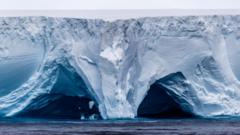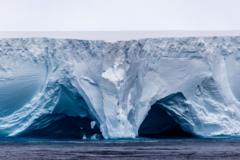A23a, an iceberg four times the size of New York City, has run aground near South Georgia after years of drifting, offering a stark reminder of changing conditions in polar regions. Its journey from Antarctica began in 2020, highlighting ecological shifts that underpin the iceberg’s unprecedented movement.
Historic Iceberg A23a Grounds Off South Georgia, Signaling Climate Concerns

Historic Iceberg A23a Grounds Off South Georgia, Signaling Climate Concerns
The world's largest iceberg, A23a, has come to a standstill off the coast of South Georgia, raising alarm over climate change effects in Antarctica.
In a significant turn of events on March 4, 2025, the world's largest iceberg, A23a, has paused its movement off the coast of the island of South Georgia, located in the South Atlantic Ocean. This massive ice formation, estimated to be four times the size of New York City, has captured attention not only for its size but also for the environmental implications surrounding its drift. While the potential for a "Titanic II" nightmare seems low, the presence of A23a raises critical questions about the future of Antarctica and global climate patterns.
The iceberg A23a originated in 1986 when it calved off from its predecessor, iceberg A23, releasing a new larger entity into the ocean. For a long duration, it was relatively stationary, residing in the Weddell Sea, situated to the east of the Antarctic Peninsula. However, in 2020, A23a's story took a transformative turn when it became dislodged from the ocean floor, beginning its journey toward open waters. By 2023, the giant iceberg was ready to venture beyond Antarctic confines.
Experts are now examining the implications of A23a's grinding halt. While local wildlife, including penguins, appear unharmed for now, the iceberg’s presence could symbolize more troubling ecological transitions in the polar regions. Scientists warn that such immense structures drifting away can be signals of broader environmental shifts, linked directly to global warming trends and their pervasive impacts.
As researchers continue to monitor the iceberg, the grounding of A23a serves as a focal point for discussions about climate change and its observable effects, further emphasizing the need for rigorous scientific inquiry into the polar environments. The event harkens a critical moment for environmental science, pushing boundaries towards understanding the delicate interplay between ice formations and a warming planet.






